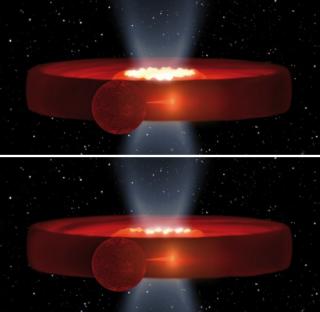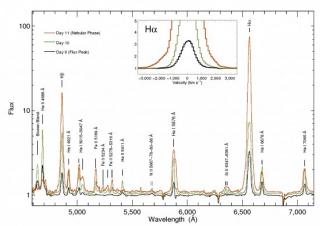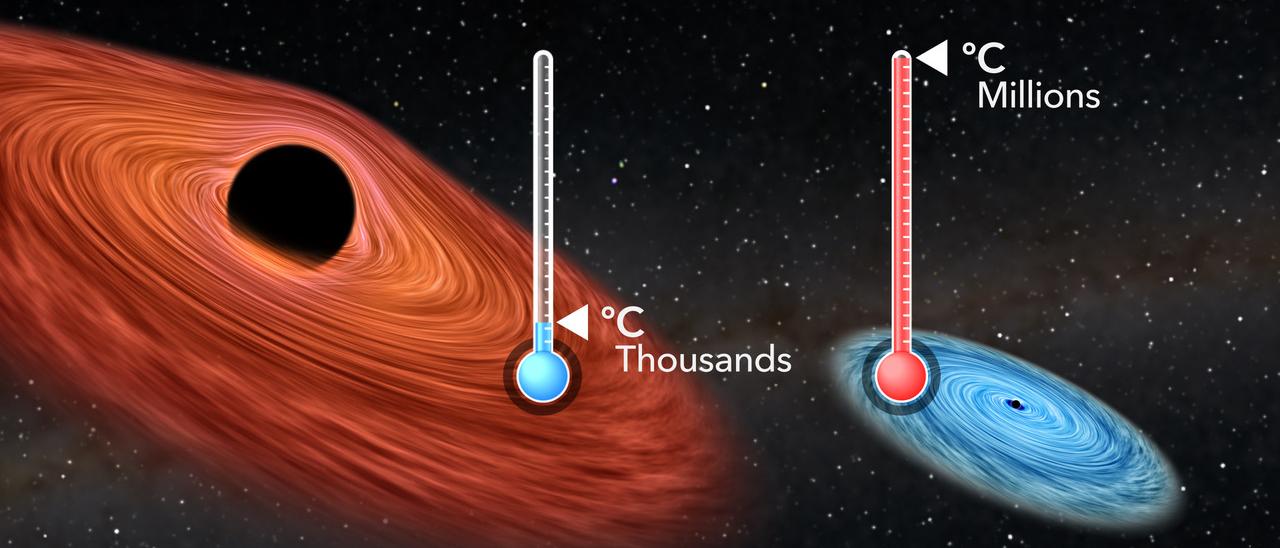Artist's illustration of a cold, heavy black hole at the centre of a galaxy, with 100 million times the mass of our Sun, heating its surroundings to thousands of degrees, compared to a smaller, superheated stellar black hole, with 10 times the mass of our Sun, but capable of heating its surroundings to millions of degrees. Credit: Gabriel Pérez Díaz (IAC)
An international research team led by researchers at the Instituto de Astrofísica de Canarias (IAC) has found a new method for measuring the masses of black holes based on the temperature of the gas which surrounds them when they are active. The results of the work have recently been published in the journal Monthly Notices of the Royal Astronomical Society (MNRAS).
The confirmation of the existence of black holes is one of the most basic results in astrophysics. There is a wide range of masses of black holes, from stellar-mass black holes, which are the result of the catastrophic final phase of very massive stars and have masses comparable to stars, to the supermassive black holes at the centres of most galaxies.
The mass of a black hole is, for the moment, the only parameter which scientists are able to measure. A recent article led by the researcher at the Instituto de Astrofísica de Canarias (IAC) Almudena Prieto, has shown an original method for measuring the mases of black holes, from those of stellar mass to the supermassive variety, based on a simple measurement of the emission spectrum of the ionized gas which is produced in the surroundings of a black hole when it is active, i.e. when it is “smallowing” the matter which falls into its gravitational field.
This new method is based on a theory first propposed in 1973, applied to binary stars which emit X-rays, each of which contain a compact object, usually a black hole, and a companion star. “This method opens a new possibility to measure black hole masses, for black holes of stellar mass, and also for intermediate mass and supermassive black holes” explains the researcher. “At the same time, thanks to its theoretical basis, the new method offers the possibility of determining the spin of a black hole as well as its mass.”
The smaller the hotter, the larger the cooler
The research has also given some results which surprised the researchers. “A curious result of this work, perhaps counterintuitive, is that the more massive the black hole, the more inactive it becomes and the cooler is the medium which surrounds it” explains Alberto Rodríguez Ardilla, a researcher at the National Astrophysical Laboratory of Brazil, and co-author of the article. “The opposite occurs when they have less mass, in which case they are able to heat the material around them to millions of degrees, although only when they are active” adds Rodríguez Ardilla
Rodríguez Ardilla was an invited researcher at the IAC on the Severo Ochoa Programme in 2014, and carried out a large part of the research which is published in this recent article during a second stay of a year, funded by the Government of Brazil in 2018. This study is part of the project PARSEC which studies, at multiple wavelengths, the nuclei of local galaxies and the accretion processes onto their central black holes. The data for the project were obtained with the Gemini South Telescope and at the SOAR observatory in Chile, thanks to the participation of Brazil in these observatories.
Article: Almudena Prieto et al: “A novel black hole mass scaling relation based on coronal gas, and its dependence with the accretion disc”. Monthly Notices of the Royal Astronomical Society, Volume 510, Issue 1, February 2022, DOI: https://doi.org/10.1093/mnras/stab3414
Contact at the IAC:
Almudena Prieto, aprieto [at] iac.es (aprieto[at]iac[dot]es)







